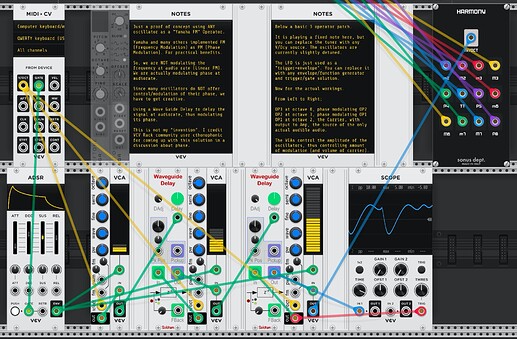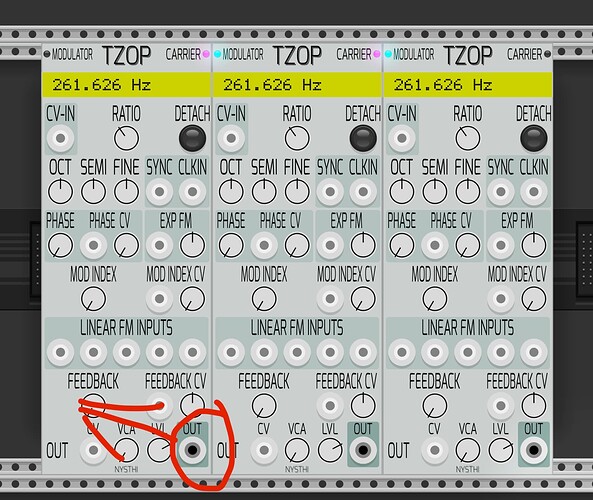Even more on Phase (Shifting):
Relative Phase (Shifting).
You can do controlled static Phase shifting of a (rich) spectrum against another (e.g. 2 Saws or Saw vs Square). This will effectively produce a Comb Filter effect. This way you can fine tune a static spectrum. And/or to modulate the relative offset a little (random/LFO) to create some liveliness, without the full cycling effect of detuning.
Compare the effect to picking one specific spectrum out of the whole cycle of spectra generated by detuning 2 “rich” oscillators.
Detuning will result in cycling the relative phase offset at the rate of the difference in frequency. Phasing frequencies in and out, wherever they are present in both spectra. At the rate of each specific frequency within the spectrum. Where higher frequencies/harmonics will phase in and out faster then lower frequencies/harmonics, thus chancing the spectrum allover but at different rates.
Interlude…
Preventing this Phasing/Combfilter Effect is why oscillator sync was “invented”. Two or more free running oscillators at unstable frequencies would never sound the same when mixed because they would be at different relative phases in their respective cycles all the time.
Syncing oscillators (a “primary/master” forcing a “restart” of the “secondary/slave” every cycle) would make their relative phase and therefore their mix predictable and static. Leaving undiscussed the “abuse” of this feature by changing the relative frequencies (screeching oscillator sync, another story).
Ironically we now crave for these analog imperfections in the perfect world of digital…
To continue…
Frequency and Phase are related. Detuning will just cause one cycle to get ever further behind another. So, effectively an ever increasing phase shift (until they eventually reach “sync” and the whole cycle starts all over).
All this assumes that both spectra have overlap in their spectrum (common harmonics/frequencies). No common frequencies within the spectrum means no frequencies will phase cancel each other where phase canceling happens when the phase shifting is introduced.
E.g. phase shifting a pure Saw (all ODD+EVEN harmonics at 1/rank amplitude) against a “pure” square (only the ODD harmonics) will leave the EVEN harmonic untouched and will give you control over the amplitude of ODD harmonics
Since “mixing” to oscillators is effectively “summing” not only the relative phase is relevant, but also the relative amplitude. Amplitude 50% can only phase out a 100% amplitude for 50%. Giving you even more control/options.
Another way to control where the “phasing” will occur is to bluntly introduce a fixed tuning offset. That will determine where in the spectrum both spectra might overlap (and frequencies in the first might phase cancel frequencies in the second when shifting). E.g. tuning #2 an octave up above #1, will leave the root of #1 untouched.
I give this specific example because normally the dominant harmonic in the spectrum determines the “note”. And generally this is the first harmonic in the spectrum. Not always…e.g. not for filtered noise (not just 1 harmonic) or some resonator instruments (not the first).
So…by choosing / controlling both spectra carefully, you can control where and when and how much the phase canceling occurs.
Hope these (way too many) words about Phase (Shifting) will help and inspire those who are interested in the many marvels of audio and synthesis.




